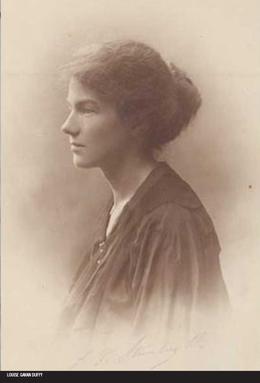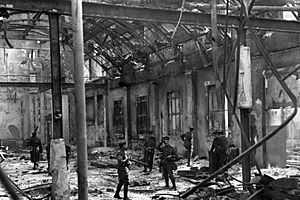Louise Gavan Duffy facts for kids
Quick facts for kids
Louise Gavan Duffy
|
|
|---|---|
 |
|
| Born | 17 July 1884 Cimiez, France
|
| Died | 12 October 1969 (aged 85) Dublin, Ireland
|
| Nationality | Irish |
| Other names | Luíse Ghabhánach Ní Dhufaigh |
| Alma mater | University College Dublin |
| Occupation | Educator, Suffragist, Nationalist |
| Known for | Founding Ireland's first Gaelscoil |
Louise Gavan Duffy (Irish: Luíse Ghabhánach Ní Dhufaigh, born 17 July 1884 – died 12 October 1969) was an important Irish woman. She was a teacher who loved the Irish language. She even started the first Gaelscoil (an Irish-speaking school) in Ireland.
Louise was also a suffragist, meaning she fought for women to have the right to vote. She was an Irish nationalist too, working for Ireland's independence. She was even at the General Post Office during the 1916 Easter Rising. This was a major event in Ireland's fight for freedom.
She was born in Nice, France. Her family was a mix of Irish, Australian, and English. Her father and brothers were important in politics and law in Ireland and Australia. Louise grew up in a lively home where she learned about political ideas. She was one of the first women to graduate from University College Dublin in 1911.
Her interest in women's suffrage and Irish nationalism led her to join these movements. She helped start two important women's groups: Cumann na mBan and Cumann na Saoirse. During the 1916 Irish Easter Rebellion, she helped by cooking for the rebels. As she became better at speaking Irish, she opened the first secondary school taught entirely in Irish in 1917.
Contents
Early Life and Education
Louise Gavan Duffy was born in France. Her father was Sir Charles Gavan Duffy, an Irish nationalist. He helped start a newspaper called The Nation. Her mother was Louise Hall from England. Her father had faced trials for his political actions. He was elected to the British Parliament in 1852. Later, he moved to Australia and became the leader of Victoria. He retired to France in 1880.
Louise's mother died when Louise was only four years old. After that, her older half-sisters, who were from her father's second marriage, raised her in Nice.
Louise's brother, George Gavan Duffy, was an Irish politician and judge. He was one of the people who signed the Anglo-Irish Treaty in 1921. Her half-brother, Sir Frank Gavan Duffy, became a top judge in Australia. Another brother worked as a missionary in India.
Discovering Ireland and Irish
Louise first visited Ireland in 1903 when she was 18. Her father had died and was buried in Glasnevin Cemetery. This was her first time hearing the Irish language spoken. She found an Irish grammar book and became very curious about it. Her father didn't speak Irish, but her grandmother, born in the early 1800s, likely did.
From 1903 to 1907, Louise traveled between France and England. She took classes in London to prepare for university. She wanted to study in Dublin but needed money. She received a small inheritance from her grandmother, which allowed her to move.
In 1907, at age 23, she began her university studies in Dublin. She lived at the Women's College because women couldn't attend all lectures at the Royal University of Ireland. She also visited the Gaeltacht (Irish-speaking areas) to improve her Irish. In 1911, she graduated from University College Dublin with a Bachelor of Arts degree. She was one of the first women to achieve this.
After graduating, she taught at Patrick Pearse's St Ita's school for girls in Ranelagh. She later earned a Teaching Diploma from Cambridge University.
Involvement in Politics
Louise Gavan Duffy supported women's suffrage, the movement for women's right to vote. In 1912, she spoke at a large meeting in Dublin. She argued that the Home Rule bill should include votes for women. She also joined Cumann na mBan, an Irish republican women's group, when it started in April 1914. She was a founding member and a co-secretary.
She knew that fighting for women's votes and for Irish independence were different goals. Her work with Cumann na mBan was mainly for Irish independence. When St Ita's school closed in 1912, Louise used the time to finish her teaching qualifications. After getting her Cambridge diploma in 1913, she returned to UCD to study for a Master's degree.
The Easter Rising
In 1916, Louise was working on her Master's paper during the Easter break. She heard rumors that the Easter Rising had started in Dublin city centre. She walked to the rebel headquarters at the GPO. There, she told Patrick Pearse, one of the leaders, that she disagreed with the violent uprising. However, she wanted to help if there was anything to do.
She spent the whole Easter week working in the GPO kitchens. She cooked for the volunteers, including Desmond FitzGerald, and even some captured British soldiers. She made sure everyone was fed. On Thursday, the women in the GPO were offered a chance to leave safely with the British Red Cross. This was because the building was being shelled and was on fire. But almost all the women refused to leave.
Louise was among the second group to leave the GPO on Friday. They tunneled through the walls of nearby buildings to avoid gunfire. Her group reached Jervis Street Hospital and stayed there for the night. The next day, Saturday, Pearse officially surrendered. Louise went to Jacob's Biscuit Factory, another rebel location, to see what was happening. She found some volunteers there who didn't know the fighting was over.
After 1916, Louise was elected to the Cumann na mBan leadership team. In 1918, she signed a petition asking for Ireland's self-rule. This petition was given to President Woodrow Wilson of the United States. While at the GPO, she had collected names of volunteers and promised to deliver messages to their families. This might have led her to join groups that helped families of those involved in the Rising. After the rebellion, many volunteers were arrested or died. These groups helped raise money from the USA to support the families.
Founding Scoil Bhríde
In 1917, Louise Duffy helped start and run Scoil Bhríde. This was a secondary school for girls in Dublin where all subjects were taught in Irish. It was one of the first of its kind and still operates today as a primary school. Her co-founder was Annie McHugh.
The Easter Rising led to the Irish War of Independence, which lasted from 1919 to 1921. During this time, Louise focused mostly on the school. However, the military sometimes raided the school. Louise later admitted that it was used for secret rebel meetings and to hide important documents. In October 1920, the Irish leader Michael Collins even met Archbishop Patrick Clune there in secret.
The war ended with the Anglo-Irish Treaty in 1921. This led to the Irish Civil War, which lasted until 1923. Louise supported the Treaty, which her brother had signed. Because of this, she left Cumann na mBan. She then helped start Cumann na Saoirse, a women's group that supported the Treaty.
After the Civil War, Louise left politics and went back to education. She worked hard to get funding for Scoil Bhríde in its early years. From 1926, the school was recognized as a teacher training school by University College Dublin. She also wrote educational books, like School Studies in The Appreciation of Art, published in 1932.
She also taught French until she retired as principal in 1944. After retiring, she spent a lot of time helping the Legion of Mary. She also helped an association that worked with French au pairs in Dublin. In 1948, she received an honorary Doctorate of Laws from the National University of Ireland.
Historical Legacy
Louise Gavan Duffy understood how important her experiences were. She recorded her memories of the events she took part in. In 1949, she shared her story about nationalist activities with the Bureau of Military History. She was part of a Radio Éireann broadcast in 1956 about the women in the Rising. In 1962, she appeared on the RTÉ TV show Self Portrait. In March 1966, she gave a lecture at UCD to mark 50 years since the Rising. This lecture was later published in a book.
In 2014, the Irish postal service, An Post, released a stamp to celebrate 100 years of Cumann na mBan. In 2016, for the 100th anniversary of the Rising, a documentary was made about seven women involved, including Louise Duffy.
Louise Duffy died in 1969 at the age of 85. She was never married. She was buried in her family's plot in Glasnevin Cemetery.


